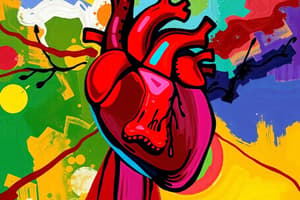Podcast
Questions and Answers
Which event marks the beginning of ventricular systole?
Which event marks the beginning of ventricular systole?
- P wave of an ECG
- R wave of an ECG (correct)
- T wave of an ECG
- Closure of the SL valves
During which phase of the cardiac cycle do the SL valves open?
During which phase of the cardiac cycle do the SL valves open?
- Ejection (correct)
- Isovolumetric Ventricular Contraction
- Isovolumetric Ventricular Relaxation
- Atrial systole
What happens during the Isovolumetric Ventricular Relaxation phase?
What happens during the Isovolumetric Ventricular Relaxation phase?
- The ventricles contract and push blood out of the heart
- The AV valves open and allow blood to flow into the ventricles
- The atria contract and push blood into the ventricles
- The SL valves close and prevent blood from re-entering the ventricles (correct)
What is the purpose of measuring blood flow, pressure changes, and blood volume throughout the cardiac cycle?
What is the purpose of measuring blood flow, pressure changes, and blood volume throughout the cardiac cycle?
Which valves are open during the Atrial systole phase?
Which valves are open during the Atrial systole phase?
What is the purpose of the Ejection phase?
What is the purpose of the Ejection phase?
What appears during the latter part of the Ejection phase?
What appears during the latter part of the Ejection phase?
What is residual volume?
What is residual volume?
What happens during Isovolumetric Ventricular Contraction?
What happens during Isovolumetric Ventricular Contraction?
When do the AV valves open during the cardiac cycle?
When do the AV valves open during the cardiac cycle?
During which phase of the cardiac cycle do the atria contract and push blood out of the atria and into the ventricles?
During which phase of the cardiac cycle do the atria contract and push blood out of the atria and into the ventricles?
What is the purpose of measuring blood flow, pressure changes, and blood volume throughout the cardiac cycle?
What is the purpose of measuring blood flow, pressure changes, and blood volume throughout the cardiac cycle?
What is residual volume?
What is residual volume?
What event marks the beginning of ventricular systole?
What event marks the beginning of ventricular systole?
Which valves are open during the Isovolumetric Ventricular Relaxation phase?
Which valves are open during the Isovolumetric Ventricular Relaxation phase?
What appears during the latter part of the Ejection phase?
What appears during the latter part of the Ejection phase?
What happens during the Isovolumetric Ventricular Contraction phase?
What happens during the Isovolumetric Ventricular Contraction phase?
When do the AV valves open during the cardiac cycle?
When do the AV valves open during the cardiac cycle?
What is the purpose of the Ejection phase?
What is the purpose of the Ejection phase?
During which phase of the cardiac cycle do the SL valves open?
During which phase of the cardiac cycle do the SL valves open?
Flashcards are hidden until you start studying
Study Notes
Cardiac Cycle Events
- Ventricular Systole Beginning: Marked by the closure of AV (atrioventricular) valves and initiation of ventricular contraction.
- SL Valves Opening: Occurs during the Ejection phase after ventricular systole when pressure in the ventricles exceeds that in the aorta and pulmonary artery.
- Isovolumetric Ventricular Relaxation: Phase where both the AV and SL valves are closed, and ventricles relax without a change in volume; pressure drops in the ventricles.
Purpose of Measurements
- Blood Flow, Pressure Changes, and Volume: These measurements are crucial for assessing cardiac function, understanding blood dynamics, and diagnosing cardiovascular conditions.
Valves During Cardiac Phases
- Atrial Systole Valves: AV valves are open to allow blood flow from the atria to the ventricles.
- Isovolumetric Ventricular Relaxation Valves: Both AV and SL valves are closed.
- AV Valves Opening: Occurs when the pressure in the atria exceeds that in the ventricles, typically during Diastole.
Ventricular Actions
- Ejection Phase Purpose: To propel blood into the arteries, crucial for systemic and pulmonary circulation.
- Latter Part of Ejection Phase: A decline in ventricular pressure occurs; residual blood volume remains in the ventricles after ejection.
- Residual Volume: The amount of blood left in the ventricles after ejection, important for understanding cardiac efficiency.
Additional Phases
- Isovolumetric Ventricular Contraction: Phase where the ventricles contract with both valves closed, leading to an increase in ventricular pressure without blood flow.
- Atrial Contraction Phase: Occurs during Atrial systole; this phase pushes blood from the atria into the ventricles, completing the filling of the heart chambers.
Studying That Suits You
Use AI to generate personalized quizzes and flashcards to suit your learning preferences.



